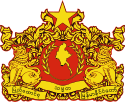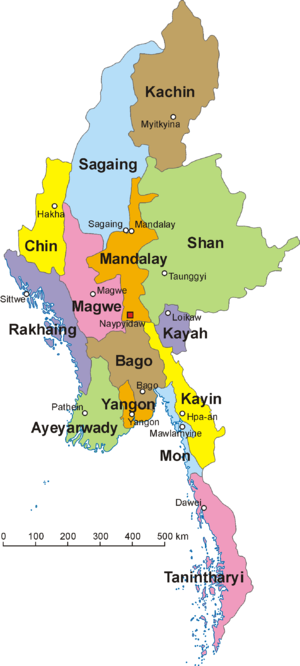- Administrative divisions of Burma
-
Burma (Myanmar) 
This article is part of the series:
Politics and government of
BurmaConstitutionExecutiveCabinet
- President (List)
- Vice Presidents
- Tin Aung Myint Oo
- Sai Mauk Kham
Legislature- Assembly of the Union
- House of Nationalities
- House of Representatives
- Political parties
Judiciary- Supreme Court
- Chief Justice: Tun Tun Oo
- Constitutional Tribunal
- Chairman: Tin Aye
Divisions- Districts
- Townships
Related topics
Burma (also known as Myanmar) is divided into twenty-one administrative subdivisions, which include- seven states (ပြည်နယ်; pyi ne, IPA: [pjìnɛ̀]),
- seven regions (တိုင်းဒေသကြီး; taing detha gyi, IPA: [táiɴ dèθa̰ dʑí]),
- five self-administered zones (ကိုယ်ပိုင်အုပ်ချုပ်ခွင့်ရဒေသ; IPA: [kòbàiɴ ʔouʔtɕʰouʔ kʰwɪ̰ɴja̰ dèθa̰]) and
- one self-administered division (ကိုယ်ပိုင်အုပ်ချုပ်ခွင့်ရ တိုင်း; IPA: [kòbàiɴ ʔouʔtɕʰouʔ kʰwɪ̰ɴja̰ táiɴ]).
The regions were called divisions prior to August 2010,[1] and five of them are named after their capital city, the exceptions being Ayeyarwady Region and Tanintharyi Region. The regions can be described as ethnically predominantly Burman (Bamar), while the states, the zones and Wa Division are ethnic minority-dominant.
Mandalay Region has the largest population and Yangon Region is the most densely populated. The smallest population is Kayah State. In terms of land area, Shan State is the largest and Yangon Region is the smallest.
States and divisions are divided into districts (ခရိုင်; kha yaing or khayai, IPA: [kʰəjàiɴ]). These districts consist of townships (မြို့နယ်; myo ne, IPA: [mjo̰nɛ̀]) that include towns (မြို့; myo, IPA: [mjo̰]), wards (ရပ်ကွက်; yat kwet, IPA: [jaʔ kwɛʔ])) and village-tracts (ကျွေးရွာအုပ်စု; kyay ywa ok su, IPA: [tɕé jwà ʔouʔ sṵ]). Village-tracts are groups of adjacent villages (ကျေးရွာ; kyay ywa, IPA: [tɕé jwà]).
Contents
Administrative regions
States, Regions and Union Territories
Name Burmese Capital Flag ISO[2] Region Population Area (km²) Type Ayeyarwady Region ဧရာဝတီတိုင်းဒေသကြီး Pathein 
MM-07 Lower 6,663,000 35,138 Region Bago Region ပဲခူးတိုင်းဒေသကြီး Bago 
MM-02 Lower 5,099,000 39,404 Region Chin State ချင်းပြည်နယ် Hakha 
MM-14 Western 480,000 36,019 State Kachin State ကချင်ပြည်နယ် Myitkyina 
MM-11 Northern 1,270,000 89,041 State Kayah State ကယားပြည်နယ် Loikaw 
MM-12 Southeast 259,000 11,670 State Kayin State ကရင်ပြည်နယ် Pa-an 
MM-13 South 1,431,377 30,383 State Magway Region မကွေးတိုင်းဒေသကြီး Magwe 
MM-03 Central 4,464,000 44,819 Region Mandalay Region မန္တလေးတိုင်းဒေသကြီး Mandalay 
MM-04 Central 7,627,000 37,021.29 Region Mon State မွန်ပြည်နယ် Mawlamyaing 
MM-15 South 2,466,000 12,155 State Rakhine State ရခိုင်ပြည်နယ် Sittwe 
MM-16 West 2,744,000 36,780 State Shan State ရှမ်းပြည်နယ် Taunggyi 
MM-17 East 4,851,000 155,801 State Sagaing Region စစ်ကိုင်းတိုင်းဒေသကြီး Sagaing 
MM-01 Northern 5,300,000 93,527 Region Tanintharyi Region တနင်္သာရီတိုင်းဒေသကြီး Dawei 
MM-05 South 1,356,000 43,328 Region Yangon Region ရန်ကုန်တိုင်းဒေသကြီး Yangon 
MM-06 Lower 5,560,000 10,170 Region Naypyidaw Union Territory နေပြည်တော် ပြည်တောင်စုနယ်မြေ Naypyidaw Central 925,000 Union Territory Self-Administered Zones and Self-Administered Divisions
Name Burmese Capital Region Population Area (km²) Type Danu Self-Administered Zone ဓနုကိုယ်ပိုင်အုပ်ချုပ်ခွင့်ရဒေသ Pindaya East Self-Administered Zone Kokang Self-Administered Zone ကိုးကန့်ကိုယ်ပိုင်အုပ်ချုပ်ခွင့်ရဒေသ Laukkai East Self-Administered Zone Naga Self-Administered Zone နာဂကိုယ်ပိုင်အုပ်ချုပ်ခွင့်ရဒေသ Lahe Northern Self-Administered Zone Pa-O Self-Administered Zone ပအိုဝ့်ကိုယ်ပိုင်အုပ်ချုပ်ခွင့်ရဒေသ Hopong East Self-Administered Zone Pa Laung Self-Administered Zone ပလောင်းကိုယ်ပိုင်အုပ်ချုပ်ခွင့်ရဒေသ Namhsan East Self-Administered Zone Wa Self-Administered Division ဝကိုယ်ပိုင်အုပ်ချုပ်ခွင့်ရတိုင်း Hopang East Self-Administered Division System of administration
The administrative structure of the states, regions and self administering bodies is outlined in the new constitution adopted in 2008.[3]
States and regions
Each state or region has a Regional Government or a State Government consisting of a Chief Minister, other Ministers and an Adovocate General. Legislative authority would reside with the State Hluttaw or Regional Hluttaw made up of elected civilian members and representatives of the Armed Forces.
Naypyidaw Union Territory
The constitution states that Naypyidaw shall be a Union Territory under the direct administration of the President. Day-to-day functions would be carried out on the President's behalf by the Naypyidaw Council led by a Chairperson. The Chairperson and members of the Naypyidaw Council are appointed by the President and shall include civilians and representatives of the Armed Forces.
Self-Administered Zones and Self-Administered Divisions
Self-Administered Zones and Self-Administered Divisions are administered by a Leading Body. The Leading Body consists of at least ten members and includes State or Regional Hlutttaw members elected from the Zones or Divisions and other members nominated by the Armed Forces. The Leading Body has both executive and legislative powers. A Chairperson is head of each Leading Body.
Within the Sagain Region[4]
- Naga (Leshi, Lahe and Namyun townships)
Within the Shan State
- Palaung (Namshan and Manton townships)
- Kokang (Konkyan and Laukkai townships)
- Pao (Hopong, Hshihseng and Pinlaung townships),
- Danu (Ywangan and Pindaya townships),
- Wa Selfadministrated division (Hopang, Mongmao, Panwai, Pangsang, Naphan and Metman townships)
History
British colonisation
In 1900, Burma was a province of British India, and was divided into two subdivisions: Lower Burma, whose capital was Rangoon, and Upper Burma, whose capital was Mandalay. Within Lower Burma were four divisions (Arakan, Irrawaddy, Pegu, Tenasserim). Upper Burma had 6 divisions (Meiktila, Minbu, Sagaing, North Federated Shan States and South Federated Shan States).
In 10 October 1922, the Karenni States of Bawlake, Kantarawaddy, and Kyebogyi became a part of the Federated Shan States. In 1940, Minbu division's name was changed to Magwe, and Meiktila Divisions became part of Mandalay District.
Post-independence
Upon independence, in 4 January 1948, the Chin Hills area was split from Arakan Division to form Chin State (Zogam), and Kachin State was formed by carving out the Myitkyina and Bhamo districts of Mandalay Division. Karen State was also created from Amherst, Thaton, and Toungoo Districts of Tenasserim Division. Karenni State was separated from the Federated Shan States, and Shan State was formed by merging the Federated Shan States and the Wa States.
In 1952, Karenni State was renamed Kayah State. In 1964, Rangoon Division was separated from Pegu Division, whose capital shifted to Pegu. In addition, Karen State was renamed Kawthule State.
In 1972, the Hanthawaddy and Hmawbi districts were moved under Rangoon Division's juridstiction.
In 1974, after Ne Win introduced a constitution, Chin Division became a state, and its capital moved from Falam to Hakha. Kawthule State's name was reverted to Karen State, and Mon State was separated from Tenasserim Division. Mon State's capital became Moulmein, and Tenasserim Division's became Tavoy. In addition, Rakhine Division was granted statehood.
In 1989, after the coup d'état by the military junta, the names of many divisions in Burma were altered in English to reflect Burmese pronunciations.[5]
After 1995, in Kachin State Mohnyin District was created out of Myitkyina District as part of the peace agreement with the Kachin Independence Army.
2008 Constitution
The 2008 Constitution stipulates the renaming of the 7 "divisions" (တိုင်း in Burmese) as "regions" (တိုင်းဒေသကြီး[6] in Burmese). It also stipulates the creation of Union territories, which include the capital of Naypyidaw and ethnic self-administered zones (ကိုယ်ပိုင်အုပ်ချုပ်ခွင့်ရဒေသ[6] in Burmese) and self-administered divisions (ကိုယ်ပိုင်အုပ်ချုပ်ခွင့်ရတိုင်း[6] in Burmese).[7] These self-administered regions include the following:
- Naga Self-Administered Zone: consisting of Leshi, Lahe and Namyun Townships in Sagaing Division
- Danu Self-Administered Zone: consisting of Ywangan and Pindaya Townships in Shan State
- Pa-O Self-Administered Zone: consisting of Hopong, Hsihseng and Pinlaung Townships in Shan State
- Pa Laung Self-Administered Zone: consisting of Namhsan and Manton Townships in Shan State
- Kokang Self-Administered Zone: consisting of Konkyan and Laukkai Townships in Shan State
- Wa Self-Administered Division: consisting of Hopang, Mongma, Panwai, Nahpan, Metman and Pangsang (Pankham) townships in Shan State
On 20 August 2010, the renaming of the 7 divisions and the naming of the 6 self-administered zones was announced by Burmese state media.[1]
See also
- Districts of Burma
- List of cities in Burma
- Flags of the Burmese states and regions
- ISO 3166-2:MM
References
- ^ a b "တိုင်းခုနစ်တိုင်းကို တိုင်းဒေသကြီးများအဖြစ် လည်းကောင်း၊ ကိုယ်ပိုင်အုပ်ချုပ်ခွင့်ရ တိုင်းနှင့် ကိုယ်ပိုင်အုပ်ချုပ်ခွင့်ရ ဒေသများ ရုံးစိုက်ရာ မြို့များကို လည်းကောင်း ပြည်ထောင်စုနယ်မြေတွင် ခရိုင်နှင့်မြို့နယ်များကို လည်းကောင်း သတ်မှတ်ကြေညာ" (in Burmese). Weekly Eleven News. 2010-08-20. http://www.news-eleven.com/index.php?option=com_content&view=article&id=4375:2010-08-20-12-39-51&catid=42:2009-11-10-07-36-59&Itemid=112. Retrieved 2010-08-23.
- ^ ISO 3166-2:MM (ISO 3166-2 codes for the subdivision of Burma)
- ^ http://upload.wikimedia.org/wikipedia/commons/a/a1/Constitution_of_Myanmar_of_2008.pdf
- ^ New administrative map of Burma page 2 of the Burma Policy Briefing by the Transnational Institute
- ^ "An Introduction to the Toponymy of Burma" The Permanent Committee of Geographic Names (PCGN), United Kingdom, October 2007, accessed 18 April 2010
- ^ a b c ပြည်ထောင်စုသမ္မတမြန်မာနိုင်ငံတော် ဖွဲ့စည်းပုံအခြေခံဥပဒေ (၂၀၀၈ ခုနှစ်) (in Burmese) [0]=1|2008 Constitution PDF
- ^ Constitution of the Republic of the Union of Myanmar (2008)
External links
Administrative divisions of Burma (Myanmar) States 
Regions Self-Administered Zones Self-Administered Divisions WaUnion Territories Articles on first-level administrative divisions of Asian countries Afghanistan · Armenia · Azerbaijan1 · Bahrain · Bangladesh · Bhutan · Brunei · Burma · Cambodia · People's Republic of China · Cyprus · Egypt1 · Georgia1 · India · Indonesia1 · Iran · Iraq · Israel · Japan · Jordan · Kazakhstan1 · North Korea · South Korea · Kuwait · Kyrgyzstan · Laos · Lebanon · Malaysia · Maldives · Mongolia · Nepal · Oman · Pakistan · Palestine · Philippines · Qatar · Russia1 · Saudi Arabia · Singapore · Sri Lanka · Syria · Republic of China (Taiwan) · Tajikistan · Thailand · Timor-Leste (East Timor)1 · Turkey1 · Turkmenistan · United Arab Emirates · Uzbekistan · Vietnam · Yemen1
1 Country spanning more than one continent (transcontinental country).Categories:- First-level administrative country subdivisions
- Lists of country subdivisions
- Country subdivisions of Asia
- Burma-related lists
- Subdivisions of Burma
Wikimedia Foundation. 2010.


